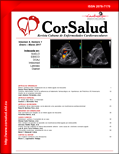Cardiac rupture as a complication of acute myocardial infarction
Abstract
Introduction: The main causes of death in patients with myocardial infarction are cardiac arrhythmias and mechanical complications. Within them, cardiac rupture causes a severe hemodynamic compromise with a high mortality rate.
Objective: To characterize patients who died of cardiac rupture as a complication of acute myocardial infarction.
Method: A descriptive, cross-sectional study at the Arnaldo Milián Castro University Hospital in Santa Clara, Cuba, between 2010 and 2014. All patients who died with a clinical diagnosis of acute myocardial infarction, who underwent autopsy and were confirmed a cardiac rupture, were studied.
Results: There were prevalence of female sex (53.2%), advanced age (more than 75 years), smoking (64.5%), hypertension (61.3%), and absence of angina (96.8%). 43 patients (69.4%) did not undergo thrombolysis, 31 of them (72.1%) had an atypical infarction presentation. Left ventricular free wall rupture (91.9%) was the most frequent. Cardiac tamponade was identified in 80.7% of the patients and cardiogenic shock in 17.7%. Almost half of those who had free wall rupture (47.3%) had an extensive extensive anterior wall myocardial infarction.
Conclusions: Female patients over 75 years old, with smoking, hypertension and diabetes mellitus predominated. Most of the patients did not have previous angina, did not receive thrombolytic treatment, and showed atypical clinical presentation. Free wall rupture was the most frequent, and almost half of those who suffered it had an extensive anterior wall myocardial infarction.Downloads
Published
How to Cite
Issue
Section
License
Authors who publish with this journal agree to the following terms:- Authors retain copyright and grant the journal right of first publication with the work simultaneously licensed under a Creative Commons Attribution License that allows others to share the work with an acknowledgement of the work's authorship and initial publication in this journal.
- Authors are able to enter into separate, additional contractual arrangements for the non-exclusive distribution of the journal's published version of the work (e.g., post it to an institutional repository or publish it in a book), with an acknowledgement of its initial publication in this journal.










